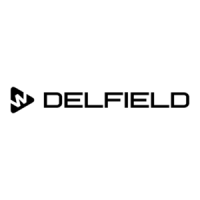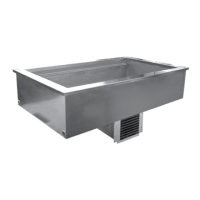8 Part Number: 9291481 05/18
Installation Section 2
16. Plumbers, electricians and refrigeration installers
should work at the same time as the equipment
installers if possible. This will allow them proper access
to their work before it is obstructed by the equipment.
17. Plumbing, electrical and ventilation provisions must
be made in floors, walls or ceilings. Utilities should be
roughed-in and surfaces finished.
Preparation For All Lines
18. All Delfield Custom Systems line-ups have been
assembled at the factory before shipment. Each unit
is marked with the work order number, SKU (item)
number and serial number. The SKU number is identical
to that marked on the sales presentation drawing. Use
these numbers as a guide during installation.
19. Starting points for an installation vary, depending on
the building layout and the type of equipment included
in the line-up.
• A good place to start assembling the line-up is
where the equipment will tie-in to an end wall or to
other equipment.
• If your line-up contains an equipment stand and
cooking equipment that requires a ventilation duct,
that would be a good place to begin.
20. Check your drawings for the correct work height.
Standard work height is 36” (91.4cm) but depending
on the installation it may be lower or higher. The work
height is the distance from the finished floor to the
stainless steel top.
Preparation For Curb-Mount Only
21. All electrical, water, drain and refrigeration lines must
be pre-plumbed.
22. It is essential that the curb is perfectly level. If the curb
has imperfections, it may be necessary to use metal
shims to achieve level units.
Refrigeration Quick Connects
23. If necessary, determine at what stage of the installation
refrigeration lines, drains and thermostat probes will be
accessible and easily connected.
24. Remove the caps from the quick connect lines and
screw them together. Tighten using two wrenches. Use
soap bubbles to look for any leaks.
25. Run the drain line to the drain pan mounted under the
compressor. Make sure to route the line so it is not
kinked or running upwards.
26. There is a T-stat probe that needs to be hooked to the
t-stat in the compressor housing. The t-stat probe ends
are keyed so they will only go into one slot. The unit
will not run correctly if the probe ends are in the wrong
slots.

